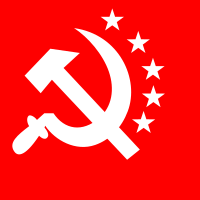Communist Party of India (Marxist-Leninist)
| Communist Party of India (Marxist-Leninist) | |
|---|---|

|
|
| Secretary General | KN Ramachandran |
| founding | April 22, 1969 |
| Place of foundation | Calcutta |
| Headquarters | New Delhi |
| International connections | International Coordination of Revolutionary Parties and Organizations (ICOR) |
| Website | www.cpiml.in |
The Communist Party of India (Marxist-Leninist) ( CPI (ML) , German : Communist Party of India (Marxist-Leninists) ) is a communist party in India . The party is ideologically oriented towards Karl Marx , Friedrich Engels , Lenin , Stalin and Mao Zedong . Its main goal is the establishment of a communist social order. It represents the necessity of a revolutionary overcoming of imperialism and its replacement by a socialist form of state under the dictatorship of the proletariat as a basic prerequisite for achieving this goal.
Program
Based on its assessment of India as a “neocolonial dependent country”, the CPI (ML) calls for the revolutionary establishment of a “people's democratic state”. Only then should the socialist revolution be put on the agenda.
history
The CPI (ML) places itself in the tradition of the communist movement in India, whose beginnings it dates back to the early 1920s.
The history of the Communists in India is characterized as in most countries, numerous divisions. Since the mid-2000s, however, there has been an increasing tendency towards collaboration among the various groups, including several associations with the CPI (ML).
Ideological trench warfare and divisions
As a result of the Sino-Soviet rift that developed from 1956 onwards, the CPI (Marxist) (CPI (M)) split off from the Communist Party of India (CPI) in 1964 . After the peasant uprising in Naxalbari in 1967, largely organized by the left wing of the CPI (M) against its own leadership, among other things , the first organization called Communist Party of India (Marxist-Leninist) emerged in 1969 as a split from this new party . The communists Charu Majumdar and Kanu Sanyal played an important role as members of the All India Coordination Committee of Communist Revolutionaries (AICCCR) founded in 1967 .
Various currents developed, which fought bitterly among themselves, sometimes entered into alliances or united and later split again; others dissolved, others were newly founded. One of the most important factions was the Communist Party of India (Marxist-Leninist) Liberation , CPI (ML) L, so-called from 1974 .
The ideological disputes within the communist movement in India revolved primarily around central questions of “the right strategy and tactics”. The assessment of the “class character” of countries like the Soviet Union or China was treated as a fundamental question and could not be separated from the tactical question. This went hand in hand with the different social orientations of the various organizations and assessments of Indian society. At the same time, groups criticized each other for practicing a policy that deviated from their fundamental statements.
Three main trends were significant:
- Groups that limited the “class struggle” to elections and reforms in the “bourgeois state”, such as the CPI and the CPI (M) with relatively strong anchoring among the workers,
- those who saw the armed struggle, the so-called "people's war", as the only legitimate means and wanted to "conquer the cities from the country", such as B. the CPI (Maoist)
- and those who used both methods or regarded them as legitimate in any way and claimed to implement a “flexible tactic”.
The CPI (ML) initially pursued a line of "extermination of the class enemy" through assassinations and similar methods, but later distanced itself from it again.
In this dispute there arose a great number of splits from the larger communist organizations, and the fragmentation of the movement was carried to extremes. All of these currents claimed to be Marxist-Leninists, which explains the immense number of competing organizations that bore the name "Communist Party of India (Marxist-Leninist)" or something similar.
CPI (ML) today
In 2005 the CPI (ML) Red Flag merged with the CPI (ML) (Kanu Sanyal). KN Ramachandran, the former general secretary of the CPI (ML) Red Flag, took over the post of general secretary of the united party. Other groups joined the organization.
The 9th party congress of the CPI (ML) took place in November 2011 - the first party congress in 40 years - it decided on a new party program and other changes in the party line.
Publications
- "Red Star" - central organ of the party, appears in English and Hindi
- “The Marxist-Leninist” - Theoretical Journal of the Party, appears in English and Hindi
- "Breaking The Shackles" - central organ of AIRWO
- "Inquilab" - central organ of AIRSO
- "Rebel" - central organ of the RYFI
- Organs of various state committees of the party
Subsidiary organizations
- All India Revolutionary Women's Organization (AIRWO)
- All India Revolutionary Students' Organization (AIRSO)
- Revolutionary Youth Federation of India (RYFI)
International
The party is a founding member of the International Coordination of Revolutionary Parties and Organizations , an association of more than 40 communist organizations from over 30 countries.
The CPI (ML) belongs to the International Conference of Marxist-Leninist Parties and Organizations .
Individual evidence
- ↑ Party program of the CPI (ML) ( Memento of the original dated February 3, 2012 in the Internet Archive ) Info: The archive link was inserted automatically and has not yet been checked. Please check the original and archive link according to the instructions and then remove this notice.